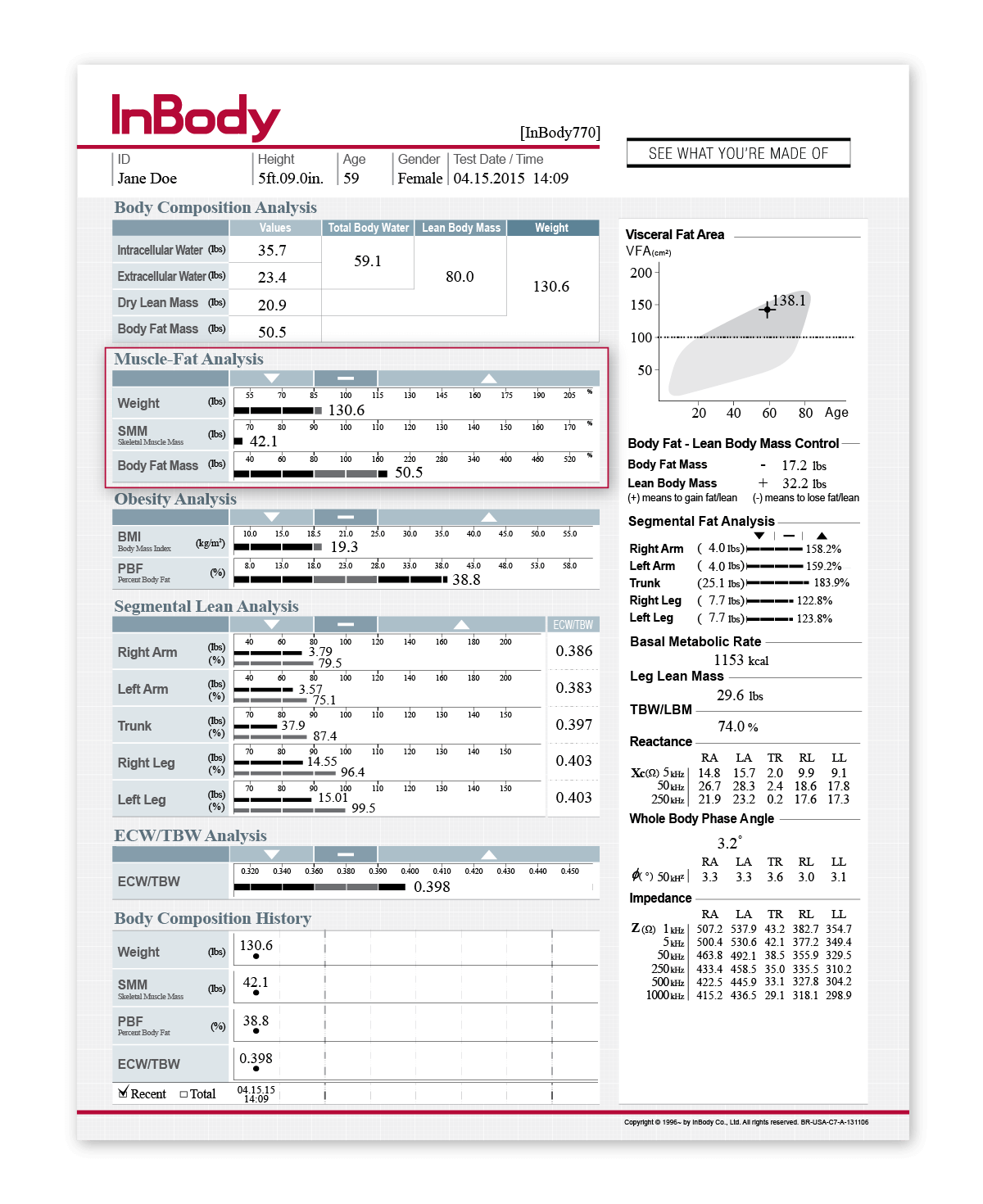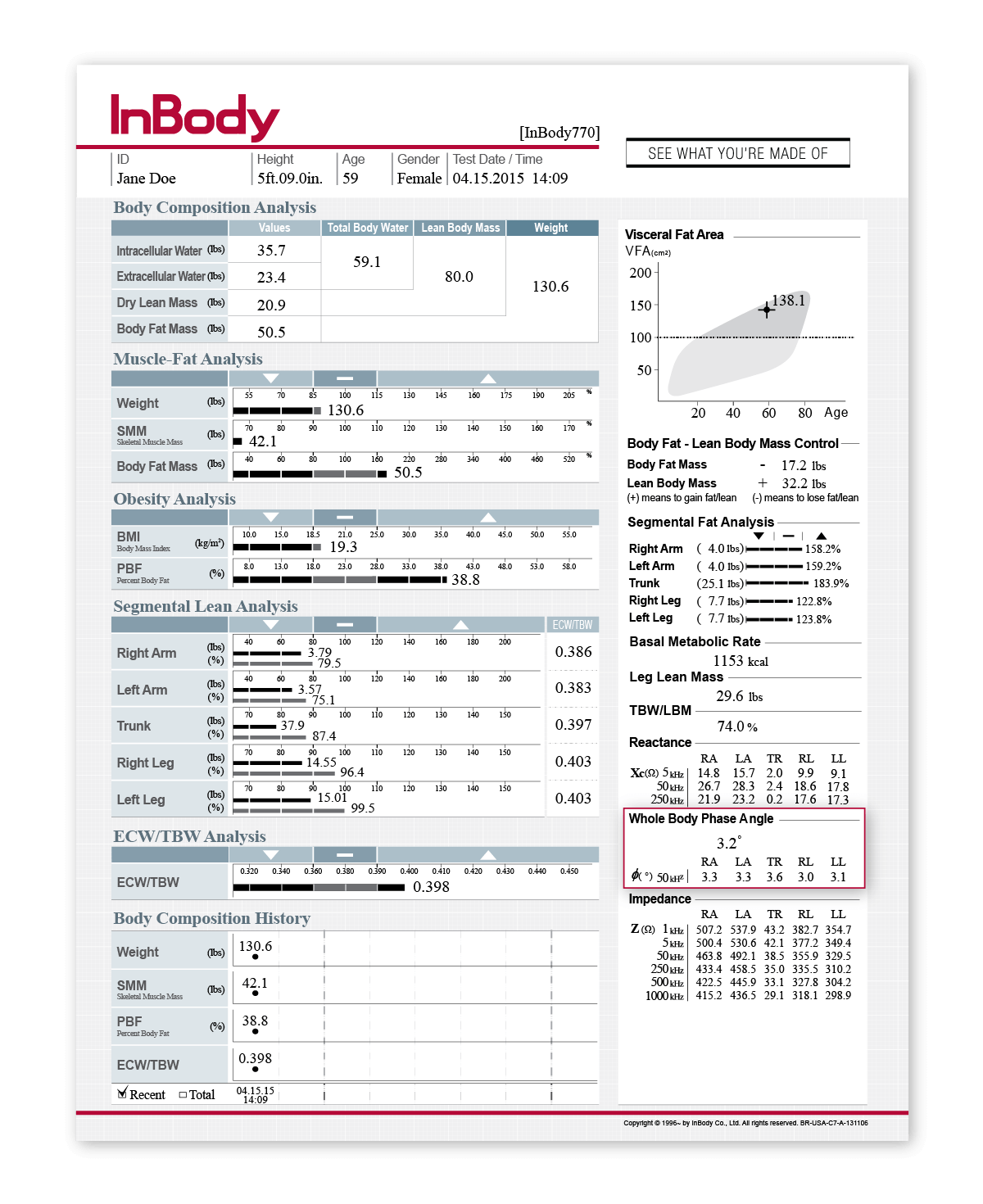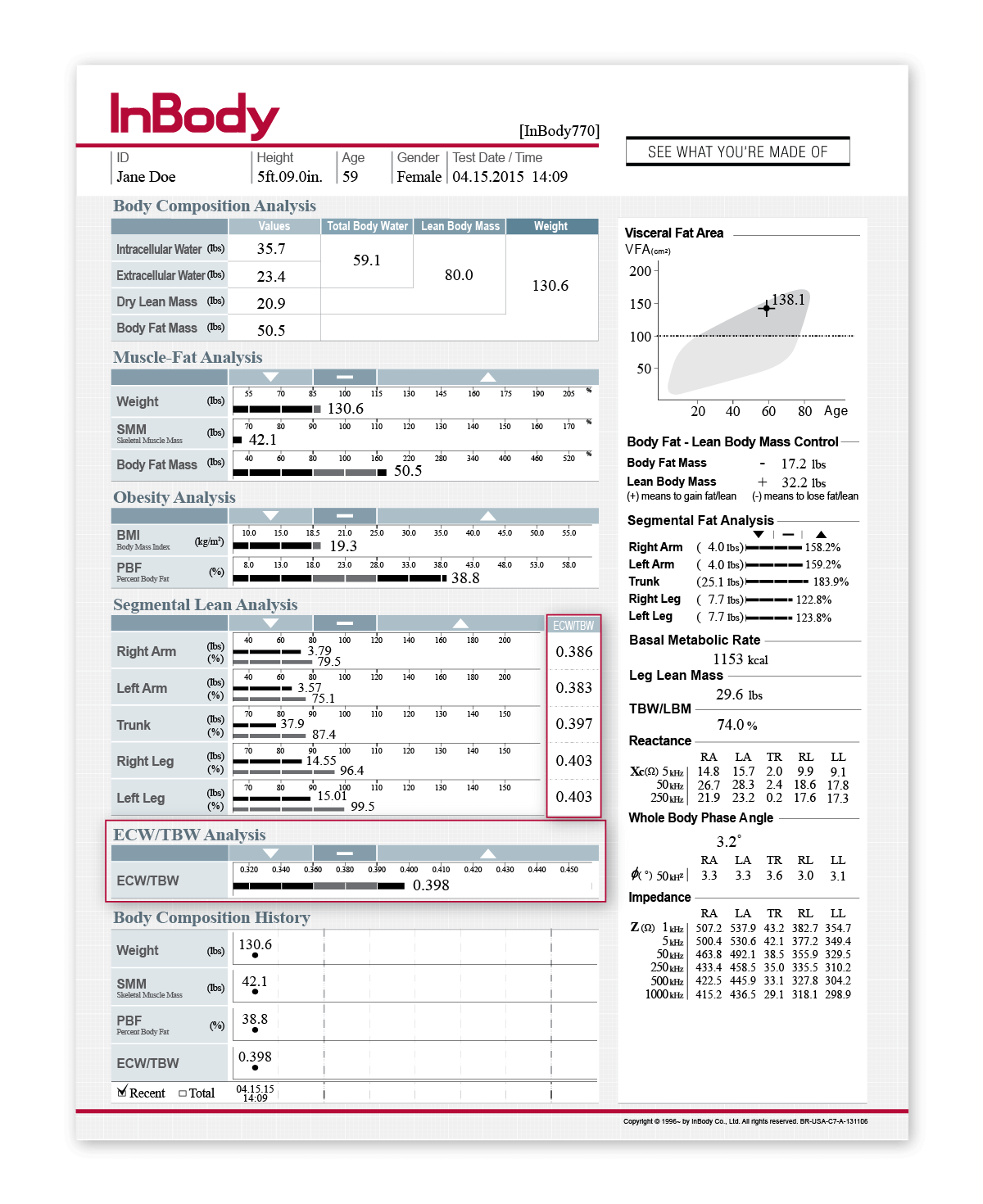

InBody devices provide a quick, easy, non-invasive and precise method for assessing health risks and the effects of interventions. In less than 60 seconds, the InBody Test can be used to:
“Here, we found that phase angle was a predictor of survival independent of many established objective laboratory markers, such as hypoalbuminemia, leukocytosis, neutrophil-to-leukocyte ratio, and elevated lactate dehydrogenase..”
“SMI was a significant independent prognostic factor for cancer-related deaths in patients with gastric or colorectal cancer who had undergone surgery, and a marginally independent factor that negatively contributed to overall survival in these patients..”
“In conclusion, gastric cancer patients, whether cachectic or noncachectic, have decreased serum leptin levels, which may depend not only on the percentage of fat mass but also on GH and insulin.”

Disease onset and progression can cause changes in body composition despite weight maintenance, which would be overlooked by BMI. Assessing muscle-fat balance allows medical professionals to monitor the effects of treatment to prevent worsening outcomes.
Cancer patients often experience significant changes in body composition, namely muscle loss, fat gain, or a combination of these factors. When these occur simultaneously, weight may not change significantly, making BMI a poor indicator of physiological change. By monitoring objective measures of muscle and fat mass, medical professionals can assess physiological changes and symptoms associated with malnutrition and cancer cachexia. Additional outputs of basal metabolic rate (BMR) aid nutritionists in setting strategies to promote muscle maintenance and management of fat gain/loss. Tracking the outcomes of these programs provides oncologists with the tools to provide more direct treatment strategies to improve quality of life and patient outcomes.


Cancer and cancer treatments cause damage to cells, compromising immune function and reducing cellular integrity. By tracking phase angle, oncologists can monitor the cellular health of patients for earlier detection of symptoms/disease progression.
Phase angle, a measure of how the cells respond to the electrical currents used to measure body composition, reflects cell membrane integrity and has been linked to survival in various oncological populations. When cells are healthy, they are better able to resist these currents utilized by the InBody, resulting in a higher phase angle. Because cancer and various treatment modalities cause damage to the cells before the loss of muscle and fat mass, this decrease in phase angle can be linked to cancer-cachexia related malnutrition as well as other medical risks/conditions. By monitoring segmental and whole body phase angle, oncologists can pinpoint the risk of specific comorbidities, track the effects of immunotherapies more precisely, and provide earlier intervention strategies for the prevention of disease progression.
For clients looking to build muscle mass, a proper dietary program is required to optimize results and ensure weight gain occurs in the form of muscle mass. Understanding a starting point as well as the desired outcome for the client helps establish a better end goal, a realistic timeline for tracking progress and direction for where changes in body composition need to occur. Through the use of BIA technology the Muscle-Fat Analysis section offers nutritionists and dietitians a better way to monitor the progress of their client’s program and allow for earlier dietary interventions to optimize their success.
While research supports the use of protein in addition to resistance training to increase skeletal muscle mass, a proper macronutrient balance is required in order to avoid plateaus and ensure that weight gain occurs in the form of muscle mass and not fat mass. By analyzing the change in the balance between muscle and fat mass, clients can be assured that the changes being made to their composition is that of a positive nature. Clients can monitor the effectiveness of their dietary regime or supplements, which ultimately provides credibility to the nutritionist’s recommendation and programming.
For clients looking to build muscle mass, a proper dietary program is required to optimize results and ensure weight gain occurs in the form of muscle mass. Understanding a starting point as well as the desired outcome for the client helps establish a better end goal, a realistic timeline for tracking progress and direction for where changes in body composition need to occur. Through the use of BIA technology the Muscle-Fat Analysis section offers nutritionists and dietitians a better way to monitor the progress of their client’s program and allow for earlier dietary interventions to optimize their success.
While research supports the use of protein in addition to resistance training to increase skeletal muscle mass, a proper macronutrient balance is required in order to avoid plateaus and ensure that weight gain occurs in the form of muscle mass and not fat mass. By analyzing the change in the balance between muscle and fat mass, clients can be assured that the changes being made to their composition is that of a positive nature. Clients can monitor the effectiveness of their dietary regime or supplements, which ultimately provides credibility to the nutritionist’s recommendation and programming.


Cancer leads to muscle loss and compromises organs and cellular functions that can lead to systemic inflammation or edema. InBody’s technology is able to precisely track fluid changes across the body to understand the cause of imbalanced fluid levels.
InBody effectively distinguishes water in the intracellular (ICW; within the tissues) and extracellular (ECW; within the blood and interstitial fluids) compartments that make up total body water (TBW). The Edema Index, based on the ratio between ECW and TBW (ECW/TBW), can be used to distinguish fluid imbalances resulting from malnutrition or edema. Managing increases in Edema Index is a priority for improving patient outcomes.
Due to the high water content of muscles, loss of muscle mass causes a reduction in ICW and results in an increased Edema Index. Thus, the Edema Index can be used to identify malnutrition separately from other disease-related fluid imbalances.
Since cancer symptoms are associated with increased systemic inflammation, progressing fluid imbalances are linked to poor patient outcomes. The Edema Index can be used to identify and monitor long-term fluid retention, which causes cellular stress and may lead to comorbidities such as renal or cardiac dysfunction. By tracking whole-body ECW/TBW, efficacy of anti-inflammatory drugs can be assessed and used to guide clinical decisions. Additionally, segmental Edema Index scores are important for identifying localized fluid imbalances in the limbs or trunk, aiding in the earlier detection of cancer-related lymphedema or circulation issues.


 DIRECT SEGMENTAL MEASUREMENT (DSM)
DIRECT SEGMENTAL MEASUREMENT (DSM)Direct Segmental Measurement allows for muscle and fat mass readings in each segment of the body: right arm, left arm, left leg, right leg and trunk. By measuring each segment of the body separately, the InBody is able to provide an in-depth analysis of a patient’s fluid balance for each region. These outputs include intracellular water, extracellular water, and ECW/TBW ratio. With objective measures of body water, including intracellular water, extracellular water, and the Edema Index (ECW/TBW), localized or systemic edema can be identified and tracked over time.
 MULTIPLE FREQUENCIES
MULTIPLE FREQUENCIESInBody devices use multiple frequencies to measure body water more accurately than commonly used methods like pitting edema scores. These high and low frequencies are able to measure both intra- and extracellular water, producing quantified and objective measurements of body water compartments. Accurate measures of the different water compartments can indicate fluid imbalances or water retention stemming from circulation issues and can be used to monitor changes in fluid balance following treatment.
 8 POINT TACTILE ELECTRODES
8 POINT TACTILE ELECTRODESInBody uses 8-Point Tactile Electrodes to ensure that measurements always start in the same place, test after test. This technology creates precise and reproducible results, ensuring that the changes professionals are seeing in their patients are accurate and comparable.
 NO EMPIRICAL ESTIMATIONS
NO EMPIRICAL ESTIMATIONSInBody devices do not rely on empirical, or pre-loaded, data to predict results. Age, gender, and ethnicity do not contribute to an individual’s results, an important factor for oncology professionals as cancer affects each patient differently. By not relying on pre-loaded data, oncology professionals can be confident that the data they are obtaining on their patient is reflective of that patient alone. Therefore, any changes that are happening to a patient reflects a genuine change in their body composition.

